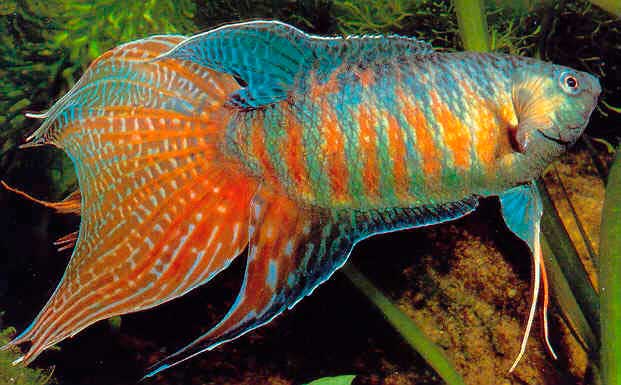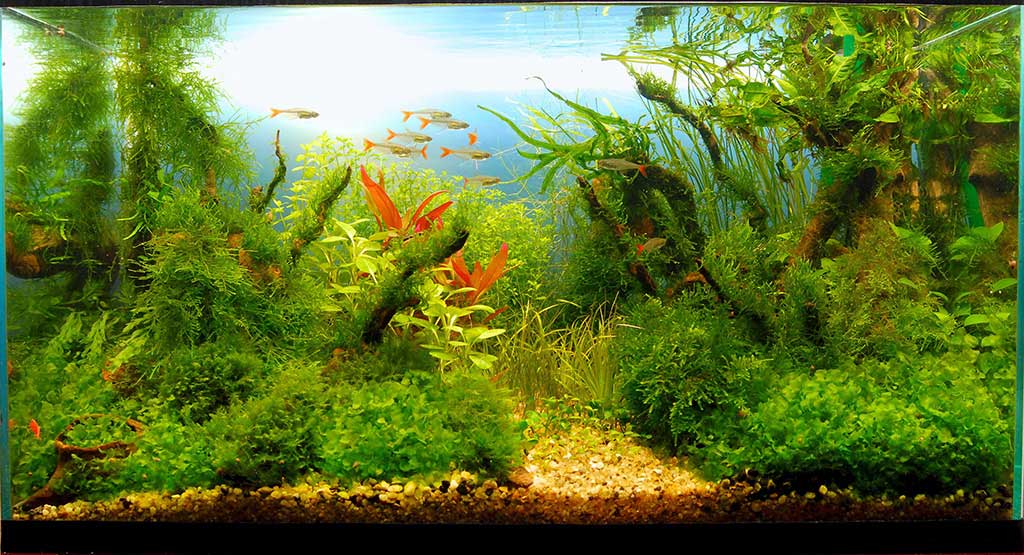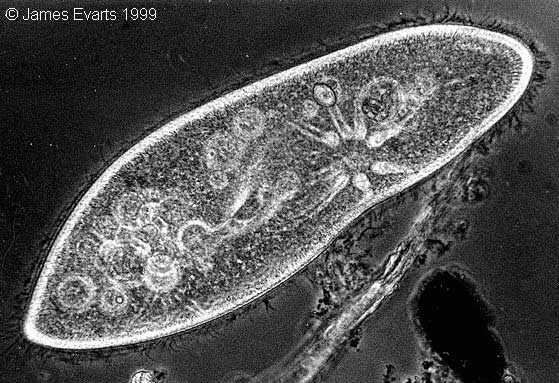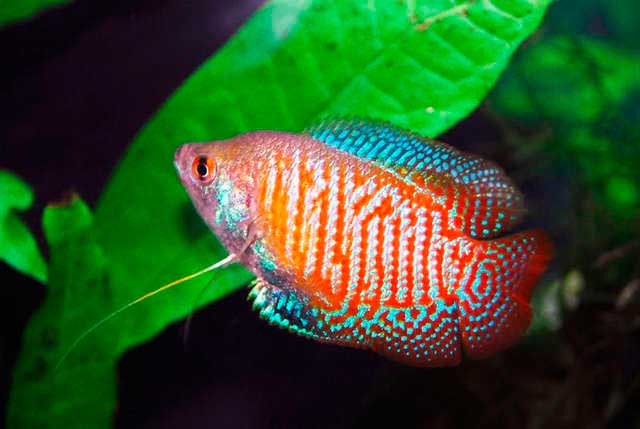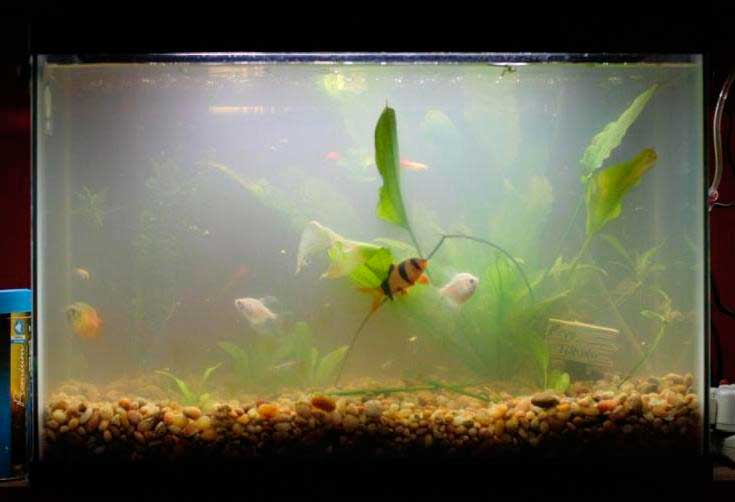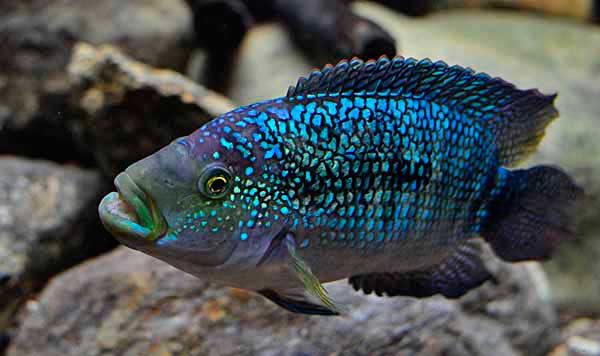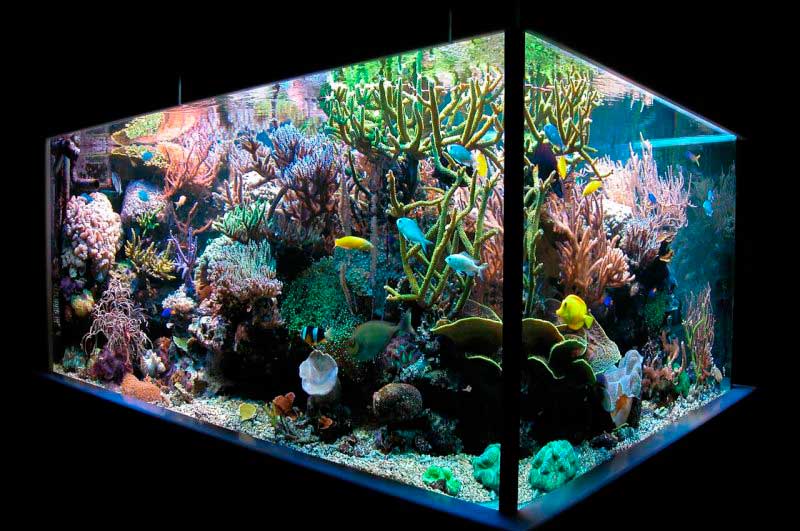Macropodus opercularis is another longtime inhabitant of our aquariums. It is believed that this is the second species, which began to contain European amateurs after the goldfish. The beauty of macropods preserved species purity is captured by one of its names. In the vastness of Russia, it is called paradise fish. Macropod is very unpretentious, hardy, disease-resistant, viable species. This may have caused the degeneration of aquarium culture.
Unpretentiousness unpretentiousness, but macropods selected for breeding should live like kings. Simplicity of maintenance, breeding led to the fact that today we are often offered to buy a living creature that has nothing in common with the beautiful coloring of his ancestors. There are macropods with the right color, but more often it is imported. A variety, which according to some data actually called paradise fish or its other name was Russian macropod, which had a bright coloring and voile fins to date is considered lost. This all speaks of the need to create macropod normal conditions of maintenance, reproduction. Carrying out breeding to preserve its natural beauty or make even more beautiful.
| kingdom | Animals |
| type | Chordates |
| class | Bony fish |
| division | Perch |
| Family | Macropods |
| genus | Macropodus |
| biological species | Macropodus opercularis |
Latin name: Macropodus opercularis
Macropodus opercularis Habitat
Macropod inhabits standing or low-flowing waters of Korea, China, Vietnam, inhabits water bodies of Taiwan Island. Sometimes can live in rice fields, inhabits even sewage ditches. This fish can withstand low amounts of dissolved oxygen thanks to a labyrinthine apparatus that allows it to breathe atmospheric oxygen. Sometimes jumped out of the water fish can lie on the floor for several hours and remain alive. Of course, such endurance is a good property, but it is still better not to get to this point. How to avoid this will be described below.
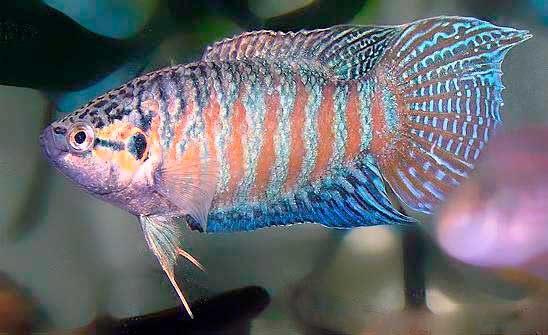
Macropodus opercularis description
The body of the macropod is oblong tall, flattened on the sides. The natural form can reach ten centimeters in length. In artificial cultivation, it is usually somewhat smaller. The coloration is very bright. Along the entire body are transverse alternating red and blue stripes, having a pearlescent cast. Anal, dorsal fins are long in the male have pointed ends. Caudal fin is bifurcated. The pelvic fins are modified – are whiskers, as in all labyrinths.
Macropod can withstand a short-term temperature drop to 10°C or increase to 35°C. Water hardness from 5 to 25 °dH. Acidity 6,5 – 8. Macropod prefers water bodies densely overgrown flora. Bright light is not desirable, it is better that the surface floated plants, which are needed as well for spawning. Sexual maturity comes when reaching six to seven months. Life expectancy macropod five – six years. Sometimes with good content lives up to eight years.
Macropodus opercularis Sex Differences
The male macropod is slightly larger than the female and more brightly colored. Dorsal, caudal and anal fins are more luxuriant, have thread-like ends. The female has a more rounded abdomen – a sign of mature eggs.
Macropodus opercularis maintenance in the aquarium
Even a three-liter jar is suitable for keeping a pair of Macropodus opercularis. However, it is still better to give them a small aquarium of at least ten liters. Common reservoir is suitable for it only if they are grown together from the fry age. If kept separately, then additional aeration or filtration is not necessary.
Be sure to cover the fish tank with glass or a lid to prevent them from jumping out of the water onto the floor. But do not close the aquarium tightly. There must be access to atmospheric air, which they breathe, periodically rising to the surface to capture it with their mouths. The glass should be 5 – 6 centimeters from the surface of the water.
As a soil you can use coarse river sand, small pebbles, gravel of fine fraction, fine expanded clay (grain size up to one centimeter).
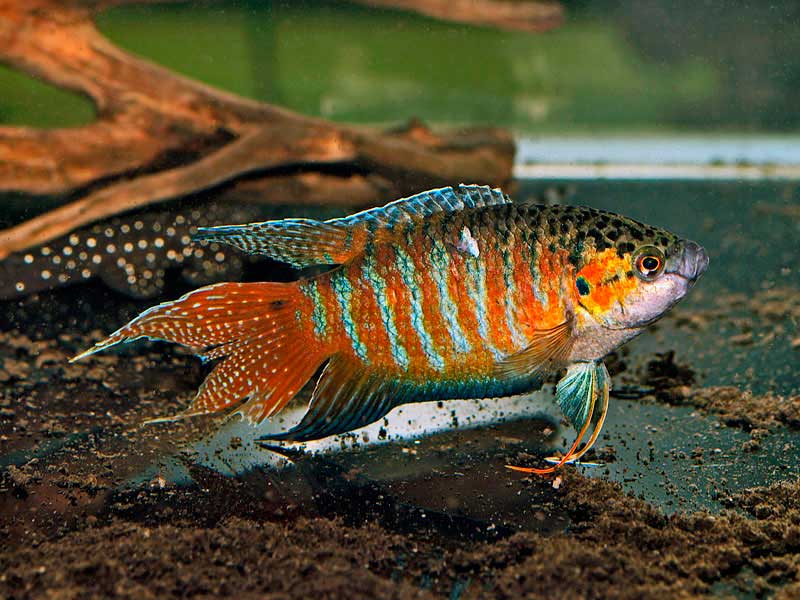
Along the back and side walls it is necessary to arrange a thicket of grasses, which the female could use as a shelter from the excited male during spawning. Flora any capable of forming dense thickets – vallisneria, cattail, peristolistnik. On the surface should float plants such as richchiya, cassava. They will shade the vessel from excessively bright light, as well as help the future dad when building a nest during spawning.
Keeping water should be 18 – 20°C. The hardness is about 10°dH. pH-7.
Macropodus opercularis compatibility
The macropod is a predatory, aggressive species. Keeping two males in one small area is not allowed. Their fights will inevitably end with the death of one of them. This applies to fish grown in proud solitude. Aggressiveness macropod sharply reduced if you grow them in a common pond from two months of age or keep them together with other species of commensurate size without veil fins, preferably not slow. To goldfish, as well as any of its breeds to plant it can not. You can keep with barbs, except Sumatran. This bully will deprive macropods their whiskers. You can keep with large representatives of the genus danio. But I repeat macropods can be kept in a common reservoir, only if they were raised in it from a fry age, otherwise do not avoid clashes.
Feeding
It is better to feed paradise fish with live food. Moths, trubichnik, bark. You can feed, frozen food (before feeding must defrost). Insects are also suitable as food. Fish is a sanitizer, which for a few days is able to clean your pond from the parasites that got into it when feeding, such as planaria, hydra. As well as Macropodus opercularis will easily get rid of snails, which are also not desirable guests, if their reproduction is not controlled. Macropod does not indulge as well shrimp, so that shrimp tank for it is also not a place.
Macropodus opercularis breeding
For breeding is suitable for a small container of about ten liters. A week before spawning, it is desirable to separate the producers in different containers. They should be abundantly fed. The spawning ground is arranged, as well as the vessel for maintenance. At the back, as well as the side walls should be thickets of plants, on the surface of the water should float riccia, cassava or other floating plants.
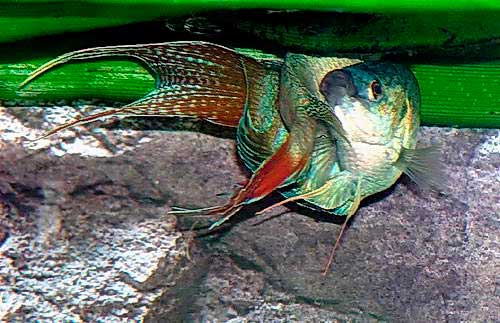
Does the spawning area need to be aerated?
Since the labyrinth in fry develops and begins to act about the third week of life, it is desirable to equip the spawning tank with artificial aeration of small bubbles. In prepared in this way, the spawning ground is planted first male. Then after a day, replace one-fifth of the water with fresh tempered. Now you can plant the female. Set the thermostat of the heater to a temperature of 24 -26 ° C.
Nest of the macropodus opercularis
The macropod, after inspecting the territory, making sure that it is safe, starts to build a nest. It is built on the surface of the water from air bubbles, using plants floating on the surface. Construction usually takes one to two days. The nest rises above the water and is seven to ten centimeters in diameter. After the nest is ready the male invites the female to it. Spawning begins, which lasts several hours. During this time, the female hatches up to 1000 eggs of yellowish color. The male as if squeezes the eggs out of the girlfriend, wrapping her abdomen with his body. Then picking up the eggs, places them between the air bubbles of the nest. The mating dance is then repeated. This way until the female gives up all the eggs. After spawning is complete the male will start to drive the female away from the nest.
It is better to remove her from the spawning ground. Then the father takes care of the eggs himself. Although literary data indicate that the female sometimes also helps to take care of the nest. And if the male something happens to the female takes all the care of future offspring on himself. In general, macropods are very zealous and caring parents. If they and show ascribed to them aggressiveness, it is by protecting their nest with offspring from curious neighbors. As for their attitude to the fry of other species, there are descriptions of how macropods tried to care for guppy fry, catching them and putting them in their nest. Also described cases when macropods stole the eggs of lalius and nursed it as their own. So the paradise fish is a very caring nanny.
When to remove the parents from the spawning ground?
After about two days, larvae emerge from the eggs. After another three to four days, the fry will swim. Now the fry will begin to feed independently. As soon as this happens it is necessary to remove the parent, turn on aeration with a weak flow and start feeding the fry. Now their fate is entirely entrusted to your care. Starter food – infusoria, nauplii artemia. In extreme cases, you can feed grinded to a powdery state of dry fodder or cooked hard-boiled egg yolk, but the results will be much worse. After about two months, the fry will acquire the color of adult fish.
For further spawning should be selected fish with the correct shape of fins and bright coloration. The stripes should have the correct shape, a clear sequence of blue and red stripes. Sexually mature Macropodus opercularis become sexually mature after reaching six to seven months of age.
Additional information
Macropod, although it has an unsociable character, if raised in isolation from society, can be a wonderful assistant to any novice or professional aquarist. As mentioned above, it will help you clean the aquarium of many parasites that can get into it with food or new plants. Some species of snails become a real nuisance, eating literally everything in their path.
From plants to fish eggs. Place a hungry macropodus opercularis in the aquarium, having first removed the other fish. After a few days from the snails will remain only their shells. Do not hide from this sanitizer parasites such as hydras, planaria. And the magnificent coloring of this fish will not leave indifferent to anyone. The only drawback – excessive aggressiveness, however, it is too often greatly exaggerated. In addition, it can be reduced by co-habitation with other fish from the fry age or keep separately, a lot of space for this will not require.
I am sure that you will not regret decorating your aquarium paradise fish. After all, individuals that have retained their bright coloring really fully justify their name.
